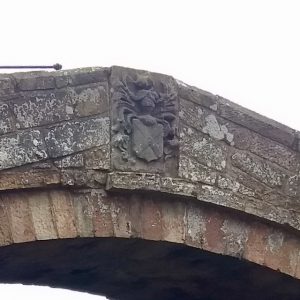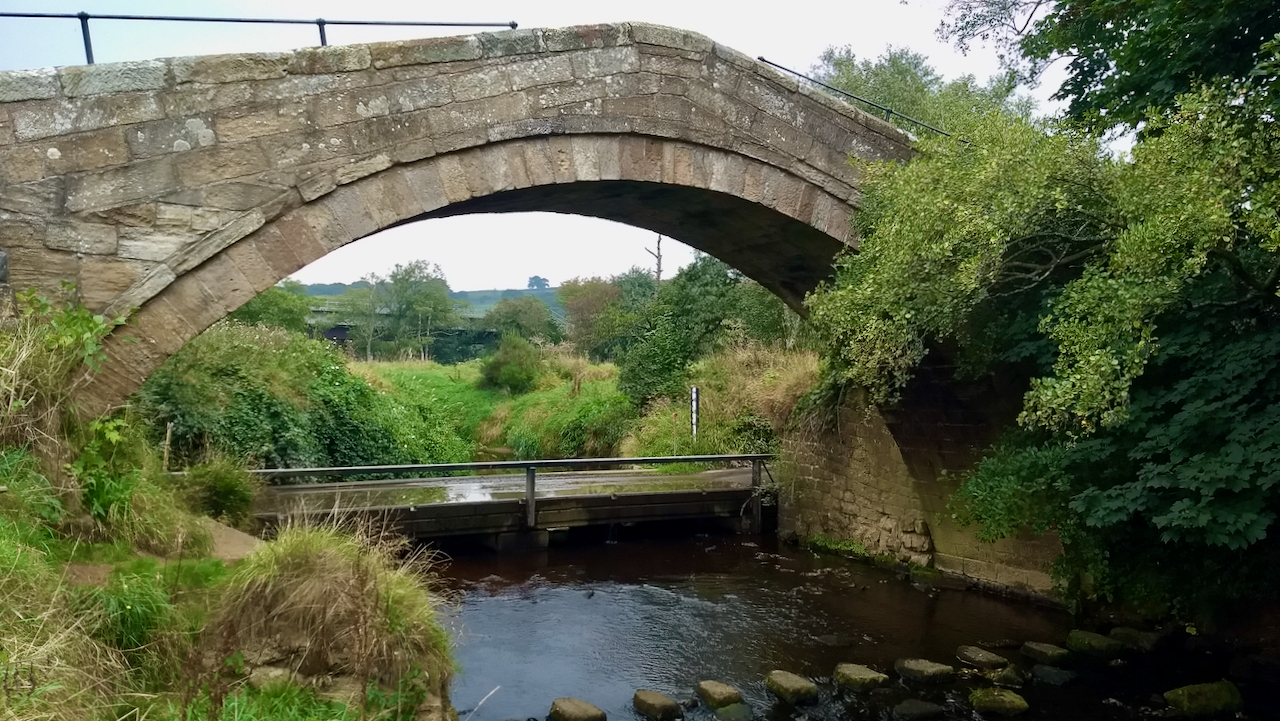I can’t believe I haven’t posted about this classic packhorse bridge before. But an otherwise dull overcast day did not provide much other opportunity for photography.
Duck Bridge, although substantially rebuilt by George Duck in 1717, is considered to date from the 14th-century1Pevsner, Nikolaus. “The Buildings of England – Yorkshire – The North Riding”. p. 135. Penguin Books. Reprinted 1985. ISBN 0 14 071009 92British-history.ac.uk. (2021). Parishes: Danby | British History Online. [online] Available at: https://www.british-history.ac.uk/vch/yorks/north/vol2/pp332-340 [Accessed 19 Sep. 2021].. It is though to be one of only about sixteen “largely unaltered” medieval single span bridges that still stand in England3Historicengland.org.uk. (2012). Duck Bridge, Danby – 1018848 | Historic England. [online] Available at: https://historicengland.org.uk/listing/the-list/list-entry/1018848 [Accessed 19 Sep. 2021]..
After the Romans had deserted Britain, masonry skills somewhat declined and timber became the favoured construction material for bridges but whether a timber bridge preceded this crossing of the Esk is uncertain. A ford may have been sufficient, accepting that in times of rapidly rising flood waters from the moorland, passage would have been impossible.
Once long distance packhorse trade routes began to be established by the monasteries, it was to their benefit that more reliable river crossings were established and local landowners would have been encouraged to construct bridges. In terrain with steep gradients rendering carts impractical, packhorse trains became the favoured method of transportation.

From the 8th century, this encouragement became an obligation, as landowners had to contribute under the ‘trinodas necessitas‘, to, inter alia, keep bridges and high roads in repair4Historicengland.org.uk. (2012). Duck Bridge, Danby – 1018848 | Historic England. [online] Available at: https://historicengland.org.uk/listing/the-list/list-entry/1018848 [Accessed 19 Sep. 2021]..
Duck Bridge was previously referred to as Danby Castle Bridge, and with a span of 12.8m and a width of 2m, has a high humpback designed to cope with high river levels. The 20th-century hand-railing on the parapets (no doubt to comply with Health & Safety) and the tar-macadam surfacing somewhat detract from the feel of a Grade II* listed medieval bridge.
The arch is quite a sophisticated construction, built with tapered stone blocks known as ‘voussoirs‘. As we know that the bridge was rebuilt in the 18th-century, I do wonder just how much of the original medieval is left. A bit like ‘Trigger’s Broom’ from the TV situation comedy ‘Only Fools And Horses’?5where Trigger claims that he’s had his road sweeper’s broom for 20 years. But then adds that the broom has had 17 new heads and 14 new handles.
- 1Pevsner, Nikolaus. “The Buildings of England – Yorkshire – The North Riding”. p. 135. Penguin Books. Reprinted 1985. ISBN 0 14 071009 9
- 2British-history.ac.uk. (2021). Parishes: Danby | British History Online. [online] Available at: https://www.british-history.ac.uk/vch/yorks/north/vol2/pp332-340 [Accessed 19 Sep. 2021].
- 3Historicengland.org.uk. (2012). Duck Bridge, Danby – 1018848 | Historic England. [online] Available at: https://historicengland.org.uk/listing/the-list/list-entry/1018848 [Accessed 19 Sep. 2021].
- 4Historicengland.org.uk. (2012). Duck Bridge, Danby – 1018848 | Historic England. [online] Available at: https://historicengland.org.uk/listing/the-list/list-entry/1018848 [Accessed 19 Sep. 2021].
- 5where Trigger claims that he’s had his road sweeper’s broom for 20 years. But then adds that the broom has had 17 new heads and 14 new handles.

Leave a Reply